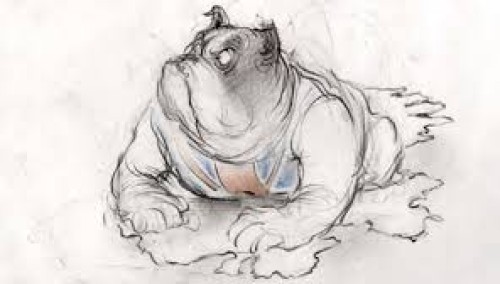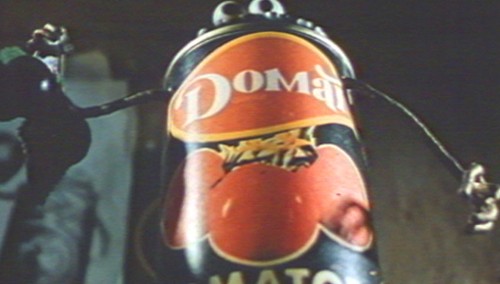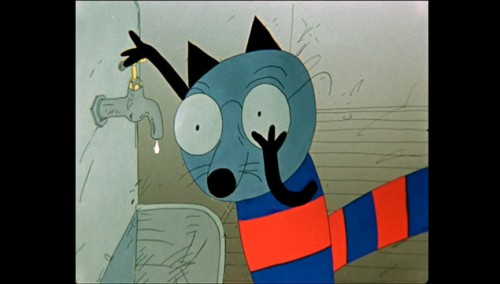„Hotel E“. On the Estonian Animation Artist Priit Pärn By Thomas Basgier
by Thomas Basgier
Overcoming the Iron Curtain in Europe was not only a protracted political historical process, but also an event that was heralded visually. In this west, however, this had a less succinct form. The sharpest critics of the Soviet system grew out of this system itself, had suffered the internal and external effects of this „real existence“ for decades, and some of them, at some point, devoted themselves to the power of images, the power of their personal images - to the subversive force of optical worlds, which could be realized relatively unhindered in presumed niche arts such as animations and therefore dared to describe the actual bankruptcy of the state control in all its despair, increasingly by means of unambiguous symbolism. The Czech artist Jan Svankmajer belongs to the ranks of these directors of eloquent imagery, as does the first, Priit Pärn.
With BREAKFAST ON THE GRASS, created in 1987, the latter magnificently demonstrated how the instruments of animation could be used to pass a damning judgement on a model of society, yet without providing the ruling apparatus with an opportunity to block the international distribution of this condemnation. BREAKFAST ON THE GRASS can certainly be characterized as a key work of the political cinema of the eighties. Another masterpiece followed in 1992: in HOTEL E (the title of which has been borrowed for the entire show) Pärn already deals with the head-on collision of a pseudo-flourishing system and a dying one, or rather with collapsed „Socialism“ being devoured by western capitalism. Shortly thereafter, Pärn conceived a performance, the motto of which sounds more optimistic than the project was intended to be, and which directly referred to HOTEL E: The Death of Dark Animation in Europe.
Priit Pärn was born in 1946 in Tallinn, first studied biology in the last sixties and worked for six years at the botanical gardens in his home town. Relatively late, not until 1976, he became involved in the field of film, although he had worked for some time before that as a caricaturist and illustrator. Today he is considered not only a distinguished director, but also an excellent graphic artist. His language of forms, through which any viewer immediately recognizes a Pärn work as such, was developed in both professions. The small corpus of the world of signs that he favored can best be characterized as a synthesis of reduction, surrealism and fractured folklore: the screen is populated by minimalistically cast physiognomies furnished with dead eyes, empty eyes, spectacled eyes, bushy eyebrows, sometimes moustaches, noses occasionally missing. And if there is a body dangling under the austere faces, then it is uniformed: with a suit, a coat, whereby ties, hats, shoes, briefcases, luggage in general and suitcases form a part of the uniform.
The Pärnian figures are set into surroundings and architectures where the windows appear as dead as the eyes of many protagonists and are otherwise marked by a disturbing emptiness. The stock of utensils needed to pointedly formulate a graphic statement, bring a picture composition to perfection, is consequently sparse: a running television, a newspaper lying around, a painting on the wall, a bicycle, scissors, an iron, cigarettes, various clocks. This minimalism in the figuration virtually provokes the use of visual leitmotifs (rabbits and rabbit ears, for instance, are a recurring theme in Pärn‘s work) and corresponds, at the same time, with the use of (non-) colors and patterns also to be taken as a leitmotif: Priit Pärn‘s films are studies in the scope of grey coloration, they work with coarse grains, with conspicuous stippling and striped motifs, and they are, not least of all, disturbing bad-weather films.
What is also fascinating about this style is the fact that it can no longer be ascribed to a singular artist. With his aesthetic, Pärn has defined a kind of sign language that numerous directors, animators and graphic artists have long since incorporated, especially in Estonia (but also elsewhere: the influence meanwhile ranges - for instance in the person of the gifted scenarist Igor Kovalyov - all the way to Hollywood). In fact, what is expressed in Pärn‘s style and the way it has been soaked up is the eternally subdued desire of a small people for national independence, a tenacious insistence on cultural identity.
In order to illustrate this, the program series „Hotel E“ is not simply arranged as a conventional retrospective. Instead, Priit Pärn is embedded in a context of relevant animation films with largely political subject matter from the period of 1986 to 1994. This confrontation is intended to raise even more tangible awareness of Pärn‘s significant role. One thing is certain in any case: disdaining animation as kid‘s stuff is clearly childish. So-called „trick films“ are quite capable of social criticism. In fact, they are capable of moving our hearts and activating our minds.

























